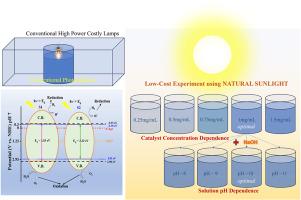Effect of pH on photocatalytic degradation of methylene blue in water by facile hydrothermally grown TiO2 nanoparticles under natural sunlight
Q3 Materials Science
引用次数: 0
Abstract
Each year, the production of synthetic dye wastewater reaches a trillion tons. This poses a significant global challenge of water scarcity. Hence, wastewater must be treated to reverse to useable water and prevent water scarcity. Failing to achieve this reversal increases ecotoxicological risks and human health. Textile wastewater contains harmful dyes. Photocatalytic degradation of these dye-contaminated wastewater is one of the major pathways in achieving reversal. However, this process is time-consuming, requires high-power lamps, and is expensive. Here, we report the effect of TiO2 nanostructures prepared by facile hydrothermal synthesis on the dye degradation of one of the most common industrial textile dyes, methylene blue (MB), under natural sunlight. The impact of particle size on the photocatalytic activity and photocarrier migration rate was thoroughly examined. The size and surface morphology of the TiO2 nanostructures depended on the concentration of the precursor during synthesis. Also, the effect of the pH of the dye solution on adsorption and photocatalytic degradation has been evaluated. With several optimized conditions, almost complete dye degradation was achieved within 40 min under the direct illumination of natural sunlight. The enhanced photocatalytic performance could correlate to the synergetic effect of a higher charge transfer mechanism, good catalytically active surface area availability (386 m2/g), and several optimized parameters that affect the reaction efficacy. Additionally, repeated use of NPs (five times) without sacrificing performance confirmed their stability and sustainability as a promising candidate for large-scale industrial textile wastewater remedies.

pH对自然光照下易水热生长TiO2纳米颗粒光催化降解水中亚甲基蓝的影响
每年,合成染料废水的产量达到一万亿吨。这构成了水资源短缺的重大全球挑战。因此,必须对废水进行处理,使其转化为可用的水,防止缺水。如果不能实现这种逆转,就会增加生态毒理学风险和人类健康。纺织废水中含有有害染料。光催化降解这些染料污染废水是实现逆转的主要途径之一。然而,这个过程耗时,需要大功率灯,而且价格昂贵。在这里,我们报道了通过易水热合成制备的TiO2纳米结构对天然日光下最常见的工业纺织品染料之一亚甲基蓝(MB)的染料降解的影响。研究了粒径对光催化活性和光载流子迁移速率的影响。合成过程中前驱体的浓度决定了TiO2纳米结构的大小和表面形貌。同时,考察了染料溶液pH对吸附和光催化降解的影响。经过几个优化条件,在自然光直接照射下,染料在40分钟内几乎完全降解。光催化性能的增强可能与较高的电荷转移机制、良好的催化活性表面积(386 m2/g)以及影响反应效果的几个优化参数的协同作用有关。此外,在不牺牲性能的情况下重复使用NPs(五次)证实了它们的稳定性和可持续性,是大规模工业纺织废水补救的有希望的候选者。
本文章由计算机程序翻译,如有差异,请以英文原文为准。
求助全文
约1分钟内获得全文
求助全文
来源期刊

JCIS open
Physical and Theoretical Chemistry, Colloid and Surface Chemistry, Surfaces, Coatings and Films
CiteScore
4.10
自引率
0.00%
发文量
0
审稿时长
36 days
 求助内容:
求助内容: 应助结果提醒方式:
应助结果提醒方式:


